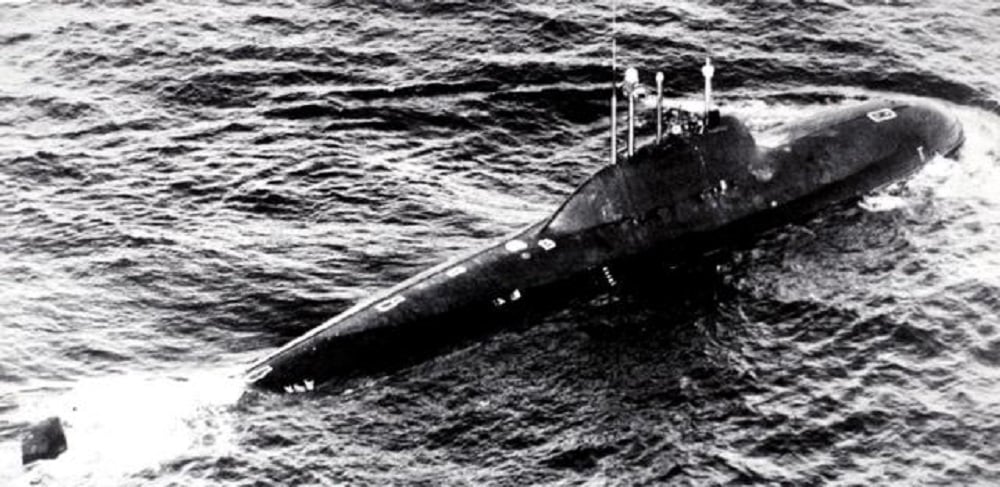Russia's Titanium Alfa-Class Submarines Had Only One Mission

The Alfa-Class was built to be fast and agile, stealthy and small. And titanium was the metal the Soviets believed would help the Alfa achieve her ambitious design goals.
Meet the Alfa-Class Submarines Made from Titanium: From the Second World War, two superpowers emerged, creating a bipolarity that would define the back half of the twentieth century. The two poles (the Soviet Union and the USA) engaged in a rampant competition – for territory, for heart and minds. And at the heart of the bipolar competition was the development of newer, better military equipment. Each nation expended vast resources to best one another (in part, the Soviet Union exhausted itself trying to keep pace with US weapons development)
Nothing motivates investment in technology, or weapons, advancement, like war. And although the Cold War never turned hot, the conflict motivated an epic spree of technology and weapons development. The Soviets raced to match the Americans and field an atomic (and then hydrogen) bomb, for example. The Soviets developed the world’s first satellite, and then launched a man into space.
The Americans followed, sending men to the moon and developing the space shuttle, the most sophisticated vehicle ever built. Aircraft development accelerated exponentially, with each nation working to field the most agile, most powerful, most impactful jets.
The speed barrier was broken, and altitude records. Eventually, the Americans developed the ability to cloak their aircraft in stealth. The Americans built supercarriers capable of projecting airpower nearly anywhere on Earth. And each nation developed increasingly capable submarines – faster, stealthier, more lethal.
In the race to develop better submarines, the Russians experimented using novel materials, namely titanium, to craft some of their hulls. The first titanium-crafted submarine was the Project 705 Lira, known to NATO as the Alfa-Class.
Alfa-Class: Experimenting with titanium submarines
In the 1960s, the Soviets began experimenting with titanium. Never before had titanium been used to craft a submarine hull; previously, only steel had been used. But the Soviets recognized the benefits of titanium – which had a low density and high strength, suggesting the metal had the potential to create a strong yet light (fast) hull.
The Soviets proceeded with the project and the end result was the Project 705 Lira or Alfa-Class.
When the Lira entered service with the Soviet Navy in 1971, she was one of the fastest submarines ever built. But more notable than the Lira’s speed was the fact that her hull had been constructed entirely from titanium – marking the first time a submarine had ever been built from the metal.
The Lira was built, of course, with the Americans in mind; in crafting the Alfa-Class, the Soviets hoped she would have the speed needed to pursue any surface ship, low detectability, the maneuverability to avoid anti-submarine weapons, minimal displacement, and a small crew.
Basically, the Alfa-Class was built to be fast and agile, stealthy and small. And titanium was the metal the Soviets believed would help the Lira achieve her ambitious design goals.
“Titanium alloy is usually stronger than steel but weighs half as [much], Brett M. Eastwood wrote. “It is more expensive, up to three to fives times more than steel. Titanium is also less corrosive in salt water. It can handle more pressure during deeper dives – all the way down to 2,200 feet.”
Yet, despite the benefits, titanium did have some downsides. “Fashioning titanium to make a hull is no easy feat,” Eastwood wrote. “Welding is difficult and the slightest mistake during the welding phase could make the titanium brittle and less strong.” Of course, a submarine hull that is brittle and weak could present problems when diving to depths of 2,200 feet.
Still, despite the potential construction pitfalls titanium presented, the Soviets were able to craft a submarine that was “state of the art” in the early 1970s. In fact, the Lira “was going to reach speeds previously unattainable and be the quietest sub in the [Soviet] navy. Titanium would be used for Lira hulls and a new lead-cooled reactor would power the ship to allow it to dive and turn quickly,” Eastwood wrote. The Lira, able to reach 41 knots, “could quickly attain that speed and adroitly switch directions when needed.”
The Americans exercise restraint on titanium submarines
In a rare moment of restraint, the US chose not to chase the Soviets in creating a titanium-hulled submarine like the Alfa-Class. While the US recognized the benefits of titanium, practical reservations won out.

“The United States was aware of the power, speed, and stealth of the Lira-class and took a close look at the titanium construction,” Eastwood wrote. But “titanium is rare and costly compared to iron. Titanium is not easy to shape either.” And given how small the margin of error was for the shipbuilders, the US was concerned that “any mis-step by the welders would create a sub that would be dangerous to take on deep dives.”

In the end, the Americans decided the “effort and cost would not be worth it.” And thus, there would never be a U.S. version of the Alfa-Class submarine after all.
- Questions and Answers
- Opinion
- Motivational and Inspiring Story
- Technology
- Live and Let live
- Focus
- Geopolitics
- Military-Arms/Equipment
- الحماية
- Economy
- Beasts of Nations
- Machine Tools-The “Mother Industry”
- Art
- Causes
- Crafts
- Dance
- Drinks
- Film/Movie
- Fitness
- Food
- الألعاب
- Gardening
- Health
- الرئيسية
- Literature
- Music
- Networking
- أخرى
- Party
- Religion
- Shopping
- Sports
- Theater
- Health and Wellness
- News
- Culture

